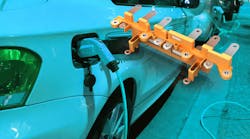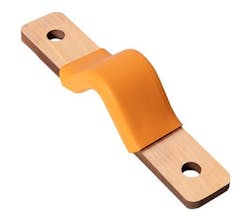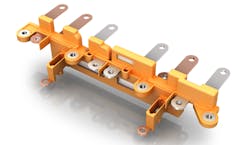Implementing Better Busbar Construction for Next-Gen Vehicles
This article is part of the TechXchange: Critical Connections: Cables, Wires, Vias, and Busbars.
What you’ll learn:
- How busbars can improve EVs, and which materials are best suited for busbars.
- What mechanical assembly challenges can be solved with these implementations?
The emergence of electric vehicles (EVs) is bringing about a transformation within the automotive landscape. Many of the largest car manufacturers announced plans to complete their migration to solely EV-centric production by the start of the next decade. Widespread vehicle electrification will have clear environmental plus points (such as dramatically reducing air pollution), but what are the implications of this from an interconnect perspective?
For gas-powered cars, it was generally specifications like acceleration and horsepower that set particular models apart from one another. However, with EVs, differentiation is focused on the powertrain/battery. Moving forward, the most valuable attributes will be:
- Making EV powertrains as efficient as possible.
- Minimizing the overall weight of all the constituent hardware.
Both attributes will allow EVs to cover greater mileage before they need to be recharged. The upshot is the “range anxiety” concerns that still put some people off buying EVs can be alleviated, and unit shipments will ramp up.
To raise EV efficiency levels, automakers and their tier-1 suppliers are implementing heightened powertrain voltages. The 400-V systems are in the process of being superseded by 800-V versions featuring high-performance power components based on gallium-nitride (GaN) and silicon-carbide (SiC) technologies. The result is that more effective high-density systems with minimal power losses can be realized. These systems also help to achieve the desired weight reductions.
With more compact and lightweight elements being incorporated into EV powertrains (including the inverters, on-board chargers, batteries, and traction motors), new approaches are needed for electrical interconnection. Automobile manufacturers are looking to replace conventional wiring arrangements in favor of the latest busbar options.
Advantages of Busbars
By using busbars, rather than conventional wiring, it becomes possible to significantly augment electrical performance parameters. In addition, assembly procedures can be dramatically simplified.
For example, cable dimensions alter due to bending, but busbars have fixed dimensions. This is highly beneficial when it comes to automated assembly, resulting in increased production output and greater profitability for vehicle manufacturers. Busbars also offer greater power capacity and heat dissipation compared to traditional wires/cabling.
Selecting the Right Busbar Materials
Busbars will usually feature either copper or aluminum conductors. If elevated temperatures and space constraints are involved, then copper’s attributes will usually make it the preferred choice.
Copper conductors have greater conductivity, so they can be physically smaller. And their superior thermal characteristics mean they’re better able to dissipate heat.
When reduction of system weight and bill-of-materials (BOM) costs are the prime objectives, use of aluminum conductors will be advisable. This is a much lower density material—conductors based on it are approximately 50% lighter than their copper counterparts. It’s also substantially cheaper.
Numerous different fill materials can be employed for busbar isolation purposes, such as polyphenylene sulfide (PPS), polyethylene terephthalate (PET), polybutylene terephthalate (PBT), and polyphthalamide (PPA). When high currents need to be dealt with, PPS’s insulation is preferred. For high voltages, PPA is usually the material of choice (because of its greater dielectric breakdown value).
Another key consideration is coefficient of thermal expansion (CTE) variation between the different materials being incorporated into busbar designs. If there are mismatches, then contraction/expansion stresses will occur within the busbar assembly as the temperature fluctuates. Selecting materials with similar CTE values will mitigate such stresses and increase the longevity of the busbar assembly.
Changes to the market pricing of materials, particularly the conductor metals, will of course have an impact on overall busbar costs, but this is unavoidable. Though wanting to minimize the cost of other elements (like the fill materials) is understandable, selecting cheaper options can shorten operational lifespan and lead to earlier replacement of busbar components. Thus, making decisions from a total cost of ownership (TCO) standpoint is a much better strategy.
Mechanical Considerations
Automotive application environments are uncompromising. Temperature cycling can cause the formation of oxidation layers on a busbar’s aluminum and copper conductors. These oxidation layers will increase resistance and ultimately impinge on interconnect performance. It may cut operational lifetime, too. The application of tin, nickel, or silver to a copper conductor surface helps diminish oxidation effects.
There’s also the issue of vibrational forces. Exposure to ongoing vibrations can affect the long-term functional integrity of interconnects. Flexible busbars often are the best way to solve the problem (Fig. 1). These comprise thin high-conductivity copper-foil lamels that are bonded together at the mounting areas through molecular diffusion welding. The lamels can slide against each other so that the connection is sustained regardless of exposure to even the most intense vibrations.
To facilitate assembly procedures, and avoid the prospect of production hold-ups, it’s also essential that acceptable tolerances are incorporated into busbar designs. This will give automated equipment enough operational flexibility when conducting assembly activities.
Attaining Adequate Insulation
The need to incorporate coatings and materials with high dielectric strengths and strong comparative tracking index (CTI) values must be accompanied by resilience to extreme temperature levels. Under some circumstances, a busbar’s internal temperature may exceed the surrounding ambient temperature. This can cause issues with the dielectrics in direct contact with the busbar conductors. One potential remedy is to apply polyester coatings.
Having good creepage and clearance values is vital to maintain safe operation. This is becoming ever-more important due to rising voltages and smaller busbar assemblies. Adding supplementary layers of insulation foil into the assembly helps extend creepage/clearance distances.
Due to the need for busbar implementations to occupy less space, technical challenges arise regarding their attachment. Foremost, bolting, welding, or clamping connections to busbars is becoming impractical.
Soldering isn’t a viable route either, because it adds another step to the manufacturing process. This will consume precious time, complicating fully automated workflows with unwanted manual involvement, leading to potential errors. Furthermore, components within the subsystem will be exposed to heat (and the risk of being damaged as a result). Solder may also affect a busbar assembly’s CTE compatibility. However, all of these issues can be dodged by using a solderless busbar connection methodology.
Even more space can be saved by integrating more system-level functionality. Electromagnetic-interference (EMI) filters and current sensor concentrators are just a couple of examples of what can be built into busbar designs.
Automobile manufacturers now need access to complex molded busbars with reduced footprints and are lighter weight. These busbars also must be optimized for the high-volume manufacturing procedures mandated by the automotive industry, enabling accelerated assembly times and preventing costly mistakes.
Conclusion
The rapid evolution of automotive designs continues to push operational demands as well as the need to reduce BOM costs and save space. It’s led to automakers turning to end-to-end fully integrated systems rather discrete interconnected subsystems.
The new breed of complex multilayer molded busbars now emerging are bringing major benefits to the automotive industry (Fig. 2). They’re presenting vehicle manufacturers with advanced interconnect solutions that have smaller dimensions, augmented performance, and assured reliability, as well as being attractive in terms of TCO.
Read more articles in the TechXchange: Critical Connections: Cables, Wires, Vias, and Busbars.


